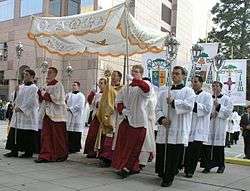Blessed Sacrament

The Blessed Sacrament is a devotional name used in the Latin Catholic, Old Catholic, Anglican, and Lutheran churches, as well as in some of the Eastern Catholic Churches, to refer to the body and blood of Christ in the form of consecrated sacramental bread and wine at a celebration of the Eucharist. In the Byzantine Rite, the terms Holy Gifts and Divine Mysteries are used to refer to the consecrated elements.[1] Christians in these traditions believe in the Real Presence of Jesus Christ in the Eucharistic elements of the bread and wine and some of them, therefore, practice Eucharistic reservation and adoration. This belief is based on interpretations of both scripture and sacred tradition. The Catholic understanding has been defined by numerous ecumenical councils, including the Fourth Lateran Council and the Council of Trent, which is quoted in the Catechism of the Catholic Church (which explains the meaning of transubstantiation).[2]
The capital city of California, Sacramento, is named for the Blessed Sacrament.
Catholic Church

The Blessed Sacrament may be received by Catholics who have undergone First Holy Communion as part of the Liturgy of the Eucharist during Mass. Catholics believe that the soul of the person receiving the Eucharist must be in a "state of grace" (i.e., not be in a state of mortal sin) at the time of reception;[3][4] to receive the Eucharist in a state of mortal sin is to commit sacrilege.
The Blessed Sacrament can also be exposed (displayed) on an altar in a monstrance. Rites involving the exposure of the Blessed Sacrament include Benediction and eucharistic adoration. According to Catholic theology, the host, after the Rite of Consecration, is no longer bread, but Body, Blood, Soul, and Divinity of Christ, who is transubstantiated in it. Catholics believe that Jesus is the sacrificial Lamb of God prefigured in the Old Testament Passover. Unless the flesh of that passover sacrificial lamb was consumed, the members of the household would not be saved from death. As the Passover was the Old Covenant, so the Eucharist became the New Covenant. (Matt 26:26-28), (Mark 14:22-24), (Luke 22: 19-20), and (John 6:48-58)
Anglicanism
Reception of the Blessed Sacrament in the Anglican Communion and other Anglican jurisdictions varies by province. Formerly, Confirmation was generally required as a precondition to reception, but many provinces now allow all the baptised to partake as long as they are in good standing with the Church and have previously received First Communion.
Devotions to the Blessed Sacrament vary. Individuals will genuflect or bow in the presence of the Blessed Sacrament, which may be reserved in a tabernacle or aumbry on, behind, or near the altar. Its presence is usually indicated by a lamp suspended over or placed near the tabernacle or aumbry. Except among Anglo-Catholics, the use of a monstrance is rare. This is in keeping with the Article XXV of the Thirty-Nine Articles that "the Sacraments were not ordained of Christ to be gazed upon, or to be carried about, but that we should duly use Them." Nonetheless, many parishes do have services of devotions to the Blessed Sacrament, in which a ciborium is removed from the tabernacle or aumbry and hymns, prayers, psalms, and sentences of devotion are sung or read. In some parishes, when the Blessed Sacrament is moved from the tabernacle (from a high altar to a chapel altar, for instance), sanctus bells are rung and all who are present kneel.
Lutheranism
In most Lutheran churches, a person must have had catechetical training prior to a First Communion (or have received Confirmation in the Lutheran Church) to receive the Eucharist. Recently, more liberal churches allow all who are baptized to receive it. Similar to the Anglican teaching, Lutherans are also taught to genuflect or bow in the presence of the Blessed Sacrament, which is normally located on an altar. In the Lutheran churches that still celebrate the Feast of Corpus Christi, like the Catholic Church, a monstrance is used to display the Blessed Sacrament during the Benediction.
See also
References
- ↑ Akselberg, Kristian. "Come and See – Some (disorganised) thoughts". Greek Orthodox Archdiocese of Thyateira and Great Britain.
- ↑ "CCC, 1376". Vatican.va.
- ↑ "CCC, 1415". Vatican.va.
- ↑ CIC 1983, c. 916.
External links
- Newadvent.org, "The Blessed Eucharist as a Sacrament". Article from the Catholic Encyclopedia
- Savior.org - Live Video Stream of the Blessed Sacrament
- Paragraph 1376 of the Catechism of the Catholic Church
- EWTN - The Holy Eucharist - Easy yet comprehensive website with Catholic Teaching on the Eucharist
- PortugueseFeast.com New Bedford's Feast of the Blessed Sacrament
- Melkite Greek Catholic Rite of Benediction